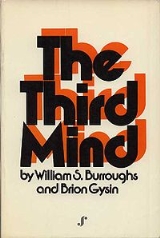
The Third Mind
Encyclopedia
The Third Mind is a book by Beat Generation
novelist William S. Burroughs
and artist/poet/novelist Brion Gysin
. First published in a French-language edition in 1977, it was first published in English in 1978.
The Third Mind is a combination literary essay and writing collection showcasing a form of writing popularized by Burroughs and Gysin in the 1960s called "cut-ups
". Cut-ups involves taking (usually) unrelated texts, literally cutting the pages up, and then combining and rearranging the pieces to form new narratives and often-surreal images. This form of writing can also be adapted for filmmaking, as demonstrated by Burroughs and director Antony Balch
in their early 1960s short film, The Cut-Ups.
The book contains numerous short fiction pieces demonstrating or related to the cut up method. Also included is poetry by Gysin and an interview with Burroughs. Some chapters had previously been published in various literary journals between 1960 and 1973.
The Third Mind (as a concept)
The significance of "The Third Mind" is that it is a shared consciousness that can only be reached by two (or more) people together-- they access a place that neither could reach alone. Person A and Person B can find new ideas in dialogue because they are improvisationally responding to each other's unpredictable mind. Burroughs was trying to access this unpredictability by cutting and rearranging texts into nonsensical riddles. By weaving the nonsense into a linear narrative, he forced himself into dialogue with an unpredictable "other". This practice builds on the classic Zen koan-- a riddle designed to transcend the "rational" mind and lead a student to satori (enlightenment).
Beat generation
The Beat Generation refers to a group of American post-WWII writers who came to prominence in the 1950s, as well as the cultural phenomena that they both documented and inspired...
novelist William S. Burroughs
William S. Burroughs
William Seward Burroughs II was an American novelist, poet, essayist and spoken word performer. A primary figure of the Beat Generation and a major postmodernist author, he is considered to be "one of the most politically trenchant, culturally influential, and innovative artists of the 20th...
and artist/poet/novelist Brion Gysin
Brion Gysin
Brion Gysin was a painter, writer, sound poet, and performance artist born in Taplow, Buckinghamshire.He is best known for his discovery of the cut-up technique, used by his friend, the novelist William S. Burroughs...
. First published in a French-language edition in 1977, it was first published in English in 1978.
The Third Mind is a combination literary essay and writing collection showcasing a form of writing popularized by Burroughs and Gysin in the 1960s called "cut-ups
Cut-up technique
The cut-up technique is an aleatory literary technique in which a text is cut up and rearranged to create a new text. Most commonly, cut-ups are used to offer a non-linear alternative to traditional reading and writing....
". Cut-ups involves taking (usually) unrelated texts, literally cutting the pages up, and then combining and rearranging the pieces to form new narratives and often-surreal images. This form of writing can also be adapted for filmmaking, as demonstrated by Burroughs and director Antony Balch
Antony Balch
Antony Balch was an English film director and distributor, best known for his screen collaborations with Beat Generation author William S...
in their early 1960s short film, The Cut-Ups.
The book contains numerous short fiction pieces demonstrating or related to the cut up method. Also included is poetry by Gysin and an interview with Burroughs. Some chapters had previously been published in various literary journals between 1960 and 1973.
The Third Mind (as a concept)
The significance of "The Third Mind" is that it is a shared consciousness that can only be reached by two (or more) people together-- they access a place that neither could reach alone. Person A and Person B can find new ideas in dialogue because they are improvisationally responding to each other's unpredictable mind. Burroughs was trying to access this unpredictability by cutting and rearranging texts into nonsensical riddles. By weaving the nonsense into a linear narrative, he forced himself into dialogue with an unpredictable "other". This practice builds on the classic Zen koan-- a riddle designed to transcend the "rational" mind and lead a student to satori (enlightenment).

